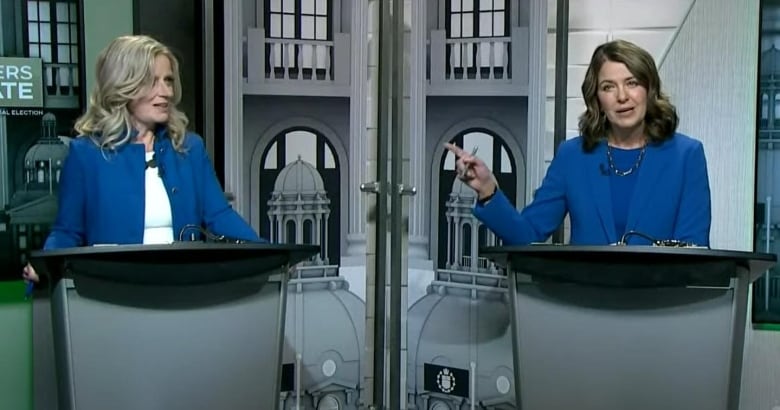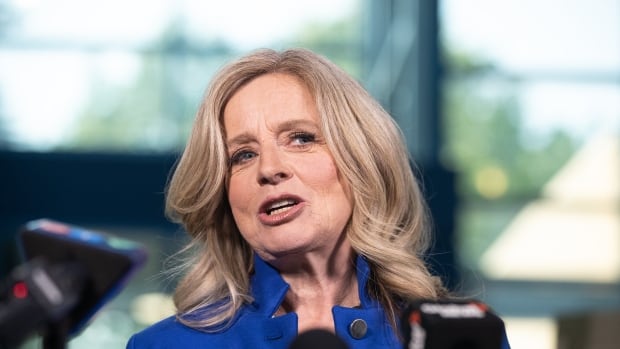In nabbing former MLA Blake Pedersen’s endorsement, the New Democrats claimed one of the most well-travelled political animals in Alberta.
He was elected in 2012 as a Wildrose MLA in Medicine Hat, alongside then-leader Danielle Smith. When she crossed the floor to Jim Prentice’s Progressive Conservatives, Pedersen did too, and then he got politically thumped in 2015 by the same party he’s now endorsing.
Between then and 2023, he’s spent most of the time backing the Alberta Party, which isn’t running a candidate in Pedersen’s current riding, or in 78 per cent of Alberta’s constituencies.
Another ex-MLA whose plug the NDP have touted is former PC minister Doug Griffiths. He’s wanted nothing to do with the UCP since Jason Kenney created that party, and had also parked his allegiances with the Alberta Party until now.
Throughout the campaign and for months previously, Rachel Notley’s party has swathed itself in blue hues. They hoped to appeal to masses of undecided former Tories who felt Smith was too extreme for their tastes, and carve out a big enough chunk of Kenney’s 2019 UCP base to win.
New polling suggests the NDP has mostly failed to scoop up those wayward conservatives. What they have managed to do, however, is absorb all the past Alberta Party voters who’ve had nowhere to go after that faction’s drift into relative obscurity.
The new Janet Brown Opinion Research poll for CBC News has Smith’s party at 52 per cent provincewide among leaning and decided voters, compared to 44 per cent for Notley’s, and one per cent for the Alberta Party and the same for some other small parties.
Compare that to the 2019 election results: 54.9 per cent UCP, 32.7 NDP, along with the 9.1 per cent the Alberta Party got without winning any seats.
To judge by Brown’s poll, Smith has hemorrhaged a few points to Notley, but nearly the entirety of the vaguely centrist AP option is going orange this year, in the most binary election Alberta has had in generations.
The centre-right is united behind the UCP, and now the centre-left is more fully united behind the NDP. This is Alberta, so that’s not anywhere close to an even match.
It appears the UCP’s relentless focus on the economy and taxes — and playing up stereotypes of how the NDP handle either — may be keeping the Kenney coalition together. This may have been enough to counteract all the unsavoury things Albertans found out about Smith and her party, from her 2021 comment likening vaccine supporters to the blithe Germans who let Nazism rise, to the ethics commissioner’s report finding her in breach for a 2023 attempt to interfere in the judicial system, and a UCP candidate’s description of transgender kids in dehumanizing terms.
On Thursday, two much more popular Conservatives got behind the UCP in hopes of fortifying the right-leaning coalition and keeping the base motivated.
When the party posted federal leader Pierre Poilievre’s endorsement video, it used the title “Let’s bring it home,” while former prime minister Stephen Harper’s appearance at a rally Thursday had a similar ring.
It may only be a temporary, fragile unity around a leader who has caused candidates many headaches at the door; but it’s a party that appears united when it counts at the campaign’s end.
And leadership liability seems to have cut both ways in the election, with Brown’s poll showing Smith and Notley tied at 42 per cent approval.
The battleground, as ever
In Calgary, Notley’s name still means more (or wounds the brand less) than Smith’s does — with a five point edge for the NDP leader in and around Alberta’s largest city, according to Brown’s poll.
And with the gap in Calgary at only three points, there are signs the NDP have done more than just scoop up all the former Alberta Party voters, but have eaten into UCP margins as well.
The race has tightened since the last subscribers-only poll Brown conducted — which somebody leaked to Postmedia, apparently in hopes of derailing narratives around NDP-friendly polls.
The UCP’s lead in the Calgary region has shifted from 12 points to three over the last few weeks in May. Since that regional subset includes satellite towns where the NDP hardly shows up like Okotoks, Airdrie and Chestermere, the two parties may be closer to tied in Calgary proper, the election’s 26-seat grand prize.
But a draw or near-draw likely translates into a tidy victory for the UCP, because the seat arithmetic means the NDP needs to resoundingly dominate Alberta’s biggest city to have a chance of overwhelming the huge firewall of dozens of seats Smith will control in rural and small-town Alberta.

Of course, this is just one poll, albeit one by the most acclaimed pollster in Alberta. And skeptics and pro-NDP optimists may look askance at some anomalous results within the poll, which shows a large lead for the UCP among 18- to 24-year-old Albertans (57 per cent to 36, a reversal of typical demographic trends), but that’s a tiny sample of 142 within a 1,200-person poll.
But the gap between first and second, centre-right and centre-left, remains wide, and it’s been that way across many publicly released surveys.
The United Conservative coalition that Kenney built, and then lost control of, appears to have not eroded, Smith’s broadly appealing economic stances proving more important than her other woollier positions that the NDP have surrounded with emergency flash beacons.
With Smith, the Wildrose movement has consumed enough of the old Progressive Conservative base to not mind so much that the disaffected types that had previously flirted with the Alberta Party are now New Democrats.
CBC News’ random survey of 1,200 Albertans was conducted using a hybrid method between May 12 and 24 by Edmonton-based Trend Research under the direction of Janet Brown Opinion Research. The sample is representative of regional, age and gender factors. The margin of error is +/- 2.8 percentage points, 19 times out of 20. For subsets, the margin of error is larger.
The survey used a hybrid methodology that involved contacting survey respondents by telephone and giving them the option of completing the survey at that time, at another more convenient time, or receiving an email link and completing the survey online. Trend Research contacted people using a random list of numbers, consisting of both landlines and cellphone numbers. Telephone numbers were dialed up to five times at five different times of day before another telephone number was added to the sample. The response rate was 5.35 per cent.


